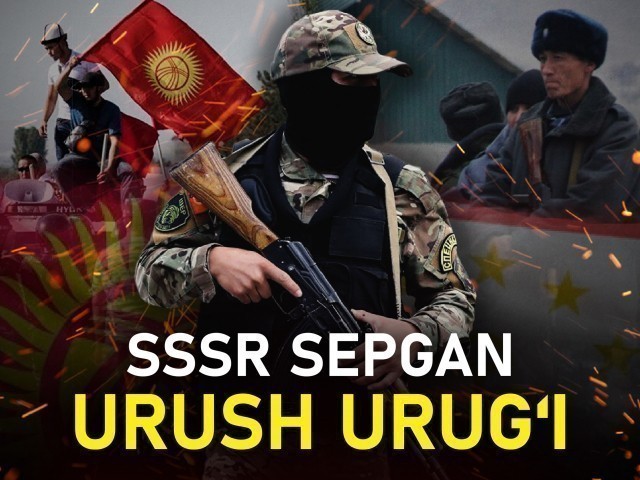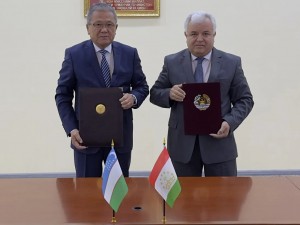The seeds of conflict that USSR sowed: What is the reason for the dissension between Tajiks and Kyrgyz?
Review
−
11 March 2022 40954
On 10 and 11 March, the long-standing wound in the Central Asian region – the Kyrgyzstan-Tajikistan border issue – deteriorated again. There was a shoot-out between the border guards of the two countries. In recent years, the countries of the region have resolved many disputes over water and territory. However, the Kyrgyz-Tajik border remains a point of contention.
So, what caused the original conflict, one that continues today, taking into consideration that 100 years ago neither Kyrgyzstan nor Tajikistan existed in the region? What led the two countries to dispute? Today, we will look for the answers to these questions.
Root of conflict
The conflict between Kyrgyzstan and Tajikistan has its roots in the Vorukh enclave.
Vorukh is a village in Isfara district of Sughd region of Tajikistan. The territory historically belonged to the Tajiks before the formation of Tajikistan at its present borders.
Looking back, the Tajikistan SSR left Soviet Uzbekistan in 1929 and became a separate state. Previously, the border between Isfara (Tajikistan) and Batken (then Black Kyrgyzstan ASSR (Autonomous Soviet Socialist Republic) was drawn on maps in 1924 by a decision of the Central Committee of the Communist Party.
There was no enclave at the time. Vorukh was directly linked to Tajikistan. Its integral status was confirmed by the resolution of the Kyrgyzstan ASSR of June 1927, in which Vorukh was listed as a direct part of the Isfara district with a population of 3,500.
The boundary between the territories of Tajikistan and Kyrgyzstan was approved by the Council of People’s Commissars in 1947 on the demarcation of the Uzbek-Kyrgyz SSR, which states that the currently disputed Vorukh was an integral part of Soviet Tajikistan.
Territorial disputes over land ownership began in the mid-1950s with the construction of the Turtkul stream and reservoir. The stream also passes through Isfara (Tajikistan) district. For the convenience of management, it was agreed to transfer to Kyrgyzstan several thousand hectares of Tajik land, in exchange for which Bishkek was to provide water for the irrigation of the above-mentioned areas.
Then the Presidium of the Supreme Council of the Tajikistan SSR did not approve the decision, but also did not give up an important infrastructure project. In fact, for the two republics which are under the Soviet Union at that time, it did not matter who owned the land. Thus, the lands of Isfara, which geographically linked Vorukh and the Tajikistan SSR, were controlled de jure by Dushanbe, and in practice by Bishkek. Problem seeds were sown.
Initially, Kyrgyz people were hired to shepherd in «donated» land, then they were given land for the construction of houses, and over time the group began to grow. How could the leaders of the republic, dependent on Moscow at that time, know that after years it would become a serious territorial problem?! Forty years later, the collapse of the mighty USSR became a reality.
Conflicts under the red flag
However, history shows that the outbreak of conflict could have been predicted long before the Reconstruction of Soviet times and the first clashes in the time of the national republics.
Thus, on the New Year’s Eve of 1974, a shooting took place in Vorukh, something the older generation still blames on the Kyrgyz side. As a result of the incident, there were injuries, but no fatalities. The incident took a serious turn, and the General Prosecutor’s Office of the SSSR was involved.
After long proceedings, the leadership of the Tajikistan SSR was recommended to transfer several hundred hectares of land in favor of the Batken region, and after the implementation of the plan Aksai village was established, and Vorukh became an enclave. At that time, Dushanbe supported this decision, but today the Tajik side is reluctant to recall the «solution», which led to further clashes.
The real conflict escalated in 1989, when the systemic problems of the union became apparent and in the republics the vote for independence became louder. Non-independent states began to seize land.
The first debates about the use of water from the Isfara river began, and soon rumors in the «offices» reached the streets and armed people. Hundreds of residents of the village of Samarkandek in the Batken region shelled mainly the Tajik village of Khojai Alo.
But this time the clash was not without casualties—a young man from a Tajik village was killed. After the first victim, the armed men of Vorukh rushed to the aid of Khojai Alo and began to clash with the Aksai people. The intervention of the Special Forces “Perm”, hastily transferred from Fergana, prevented a large-scale bloodshed.
A stakeholder commission was then convened and proposed that 68 hectares of mountainous land around the village of Vorukh and 18 hectares of land around the disputed village of Khojai Alo would be transferred to Tajikistan, thus closing the border issue. However, this did not solve the problem of the actual formation of the enclave, and therefore Dushanbe did not agree to such an offer.
It is possible that the parties would have come to an agreement if they stayed under the control of Moscow, but now that was impossible. After all, the USSR would soon collapse. The disputed territories had reached millions of hectares – Dushanbe, Bishkek and intermediary Moscow had temporarily forgotten about the Vorukh problem.
Dissension forgotten in the early years of independence
During the 15 years of independence, the national republics paid little attention to the issue of territorial boundaries. Because Kyrgyzstan was involved in a relatively bloody and terrible conflict with the Uzbeks in Osh. Tajikistan, devastated by the civil war of 1992-1997, worked hard to rebuild its economy.
Meanwhile, the «tulip revolution» took place in Kyrgyzstan, and President Askar Akayev, who was careful in his relations with his neighbors, left the country. The new Bishkek Government, which had decided to score political points by resolving the territorial issue, began to recall old problems. By this time, Tajikistan also achieved some stability and was ready for border diplomacy. This put an end to the peaceful period of the conflict.
Between Dushanbe and Bishkek, many issues had to be resolved: the local people actively used the infrastructure of the enclave, and the Batken regional administration requested a transport corridor with the village of Samarkandek.
Finally, in 2007, Tajikistan agreed to build a road on its territory and leased several hundred meters of land for 49 years. But today, the vast majority of Tajiks say that this decision was wrong. Of course, there is a reason for this. Bishkek misunderstood Dushanbe’s friendly decision, saying that Tajikistan feared the Tajiks and the Kyrgyz side began to claim its territory. It is unfair to say that Bishkek worked honestly.
Over the past 10 years, there have been no serious clashes over the perennial problem of Central Asia, and the parties have remained cool. Another revolution in Kyrgyzstan, the events of April and June 2010, the overthrow of President Bakiyev and the success of the interim Government led by Roza Otunbaeva temporarily prevented the conflicts from escalation. During this time, both sides of the disputed border became centers of smuggling. Perhaps buying and selling the product has served to rally the local population more than politicians' high-sounding speeches about friendship between two nations.
Kyrgyz farmers living in the border area were more inclined to sell their cows and sheep to their neighbors behind the borders than to the domestic market – livestock products were easily transported and were always in demand. The clandestine cattle market has survived to this day, and even radical measures by Bishkek have failed to stop it.
Active conflicts around Vorukh
No matter how much smuggling flourishes among the population, the real territorial problem has not gone away, and has gained power with some stops as time goes by. And, those moments did not last long. In April 2018, more than 50 representatives of the border villages of Uch-Dobo (Kyrgyzstan) and Khojai Alo (Tajikistan) clashed.
The clashes began with a trivial incident, in which a representative of a Kyrgyz village erected a fence on an uncoordinated and banned part of the border.
According to the Kyrgyzstan Border Service, the clashes, in which about 50 people from both sides took part, have turned into a stone fight.
Two months later, Kyrgyz and Tajik border guards clashed on a football field and the Tajik military fired warning shots. It is believed that this was because the market was created on «no man’s land». Since then, the history of Vorukh has become an important part of the serious land dispute between the two countries.
Small skirmishes erupted later- around 10 a year, but were handled by the security forces on both sides of the border.
However, in 2019, serious clashes launched. In mid-March, Tajik citizens blocked the road for Kyrgyz workers laying the Aksay-Tamdik ring road. Residents of nearby Kyrgyz villages came to the aid of road builders. As a result, about 200 people threw stones at each other. Twelve people were injured by the conflict.
Then the shootings began and there were reports of the first casualties. First, a Kyrgyz policeman was wounded, then a Vorukh inhabitant.
Armed Kyrgyz soldiers shelled on citizens of Tajikistan. At the same time, it is known that one person is injured. Another citizen, Rafoiddin Teshayev, was killed. It is alleged that the bullet was fired from a sniper rifle», – Vorukh inhabitants.
Fortunately, Dushanbe and Bishkek realized that the conflict could continue on the Osh scenario and become bloodier with arson, an inter-ethnic holocaust and the involvement of regular troops. Therefore, the parties signed a protocol to stabilize the situation while maintaining the status quo without unnecessary conditions.
However, the diplomatic agreement did not address the root causes of the problem, but temporarily suspended it. A promising meeting between President Emomali Rakhmon of Tajikistan and then President Sooronbay Jeenbekov of Kyrgyzstan also contributed little to ending the conflict.
Peace on the border lasted eight months, and in the autumn of 2019, Kyrgyz border guards opened fire on Tajikistan. Eventually, this ended in a small war of border guards. Both sides accused each other of building a military objects on the border. Later various reasons arose.
During the clashes, a Tajik lieutenant colonel and two soldiers were killed, and 12 others were injured. An officer of the Kyrgyz Special Forces was killed, and 13 people were injured. Bishkek and Dushanbe deployed additional troops to the border, but there was no need to use them. The citizens did not even have to look for a reason to quarrel. They often stoned and quarreled with each other.
In 2020, the situation on the border was relatively calm due to the pandemic. Nevertheless, there were casualties. At the beginning of May, there was another armed clash, in which the number of casualties has not been reported. In late summer, a civilian was shot dead in Isfara and a Kyrgyz border police officer was wounded.
CSTO which has a shell but not soul
The conflict on the Kyrgyz-Tajik border has shown that the Russia-led Collective Security Treaty Organization (CSTO) has no real influence.
The organization, which brings together members of the former Soviet Union close to Russia, was created to jointly respond to external threats. Its main force is the Russian army. But in the Kyrgyz-Tajik conflict, the CSTO remains a useless institution. For example, it is useless to ask for help from an organization when Dushanbe is arguing with a neighbor. Because the other side is also part of the same military block.
The CSTO takes account of external threats and has no authority or mechanism to resolve conflicts between its members. But the fact that the allies are in conflict with each other shows that the organization has neither body nor soul. Or the organization works only when Russia needs it, as it did in Kazakhstan.
When it comes to the Kyrgyz-Tajik border, CSTO has not proposed a solution in this regard. Even if the joint peacekeeping forces of the organization are included in the conflict zone, this will be an additional lever for the country whose army is deployed to control the warring states.
Negotiations between the parties
At the same time, Bishkek and Dushanbe somehow attempted to resolve their conflicts peacefully. Negotiations were held, and realistic proposals were made to resolve the conflict on disputed lands.
Last March, President of the State Security Committee of Kyrgyzstan Kamchibek Tashiyev proposed a more radical solution. According to him, Bishkek indicated two ways.
“First, we legally measure the boundaries of the enclave, and they will not change any more. But we will give the enclave a road through our territory only for use”,-Tashiyev suggested.
On the second option, the Kyrgyz Government is ready to exchange the enclave of Vorukh.
«If this enclave of 12 thousand hectares remains with us, we are ready to give 12 thousand hectares from other districts of the Batken region», - the head of the State Committee of National Security of Kyrgyzstan said.
But Dushanbe did not respond diplomatically. However, internet users could not resist throwing various insults at Tashiyev.
The visit of Tajik President Emomali Rahmon to Vorukh should have clarified Dushanbe’s position. However, during the visit, Rahmon made it clear that the enclave would not be replaced.
"I want to stress another important point, that in the entire negotiation period – 19 years – there was no matter of replacing Vorukh with another region, and that is impossible to remedy, even in the future,"- Emomali Rahmon said.
He also emphasized that the delimitation of borders was a complex process that required great efforts and mutual respect for the interests of the parties.
In general, although both sides are trying to find a peaceful solution to the problem, there is no real solution yet.
Live
All




